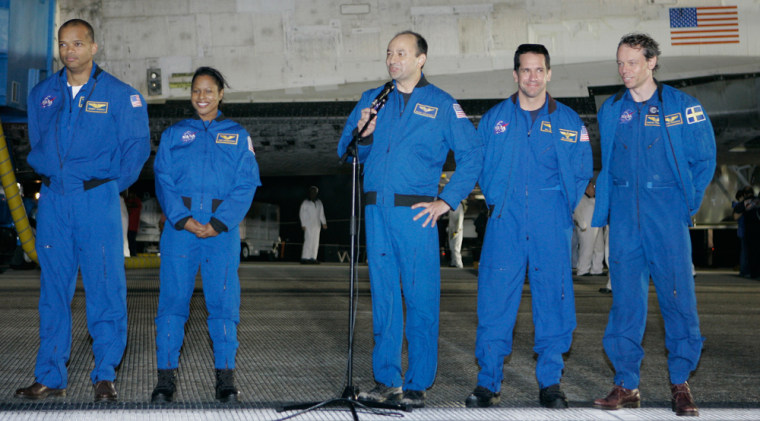Even though he goes to college in the shadow of the Kennedy Space Center, Adam Humphries can’t name any of the astronauts who just returned home on space shuttle Discovery.
And he has no idea why they paid a visit to the international space station.
“It’s not something that everybody is really into,” said Humphries, 18, a student at Brevard Community College, less than 10 miles (16 kilometers) from the space center. “It’s not interesting anymore. There’s nothing new that everybody can catch onto.”
NASA’s image-makers are taking a hard look at how to win over Humphries’ generation — media-saturated teens and 20-somethings growing up on YouTube and Google and largely indifferent to human spaceflight.
Recent surveys show young Americans have high levels of apathy about NASA’s new vision of sending astronauts back to the moon by 2020 and eventually on to Mars.
“If you’re going to do a space exploration program that lasts 40 years, if you just do the math, those are the guys that are going to carry the tax burden,” said Mary Lynne Dittmar, president of a Houston company that surveyed young people about the space program.
High levels of indifference
The 2004 and 2006 surveys by Dittmar Associates Inc. revealed high levels of indifference among 18- to 25-year-olds toward manned trips to the moon and Mars.
The space shuttle program is slated to end in 2010 after construction of the international space station is completed with 13 more shuttle flights. The recent 13-day mission by Discovery’s seven astronauts was part of that long-running construction job.
When the shuttles are retired they will be replaced by the Orion spacecraft, which NASA hopes takes humans back to the moon and then on to Mars.
Even though the Dittmar surveys offer a bleak view, NASA Administrator Michael Griffin believes ventures to the moon and Mars will excite young people more than the current shuttle trips to low-Earth orbit.
“If we make it clear that the focus of the United States space program for the foreseeable future will be out there, will be beyond what we do now, I think you won’t have any problem at all reacquiring the interest of young people,” Griffin said in a recent interview.
Support from Captain Picard?
At an October workshop attended by 80 NASA message spinners, young adults were right up there with Congress as the top two priorities for NASA’s strategic communications efforts.
Tactics encouraged by the workshop included new forms of communication, such podcasts and YouTube; enlisting support from celebrities, such as actors David Duchovny (“X-Files”) and Patrick Stewart (Capt. Jean-Luc Picard on “Star Trek: The Next Generation”); forming partnerships with youth-oriented media such as MTV or sports events such as the Olympics and NASCAR; and developing brand placement in the movie industry.
Outside groups have offered ideas too, such as making it a priority to shape the right message about the next-generation Orion missions.
And NASA should take a hint from Hollywood, some suggested.
“The American public engages with issues through people, personalities, celebrities, whatever,” said George Whitesides, executive director of the National Space Society, a space advocacy group. “When you don’t have that kind of personality, or face, or faces associated with your issue, it’s a little bit harder for the public to connect.”
Creating heroes, fighting myths
Whitesides said the agency could pick the crews for the moon and Mars trips earlier so the public can connect the faces with the far-off missions of the future.
“You can take advantage of these personalities and these stories about triumph over adversity to create heroes, if you will,” said workshop leader Peggy Finarelli, a former NASA official who is now a researcher at George Mason University.
Slideshow 12 photos
Month in Space: January 2014
Others recommend developing a junior astronaut training corps similar to the ROTC; marketing through podcasts or ring tones; and offering zero-gravity flights to winners of contests like the Little League World Series.
But embracing YouTube is no guarantee that NASA will get the results it wants.
Ali Kuwait, 19, who is studying civil engineering at Brevard Community College, said he recently watched a clip on YouTube that made a convincing case that NASA’s moon landings between 1969 and 1972 were faked.
Repeating an old myth that NASA hasn’t been able to kill, Kuwait said: “The moon thing was not real.”
An earlier version of this report misstated NASA's deadline for sending humans back to the moon.

